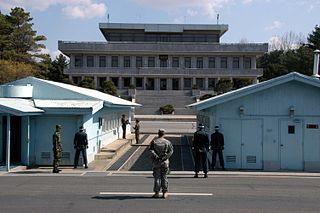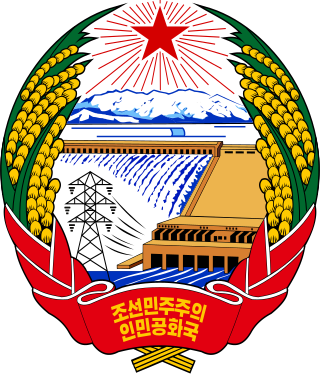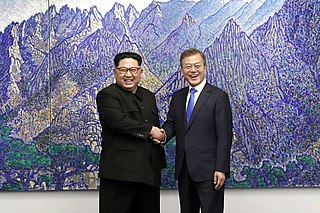| |||||
| Centuries: | |||||
|---|---|---|---|---|---|
| Decades: | |||||
| See also: | Other events of 1996 Years in North Korea Timeline of Korean history 1996 in South Korea | ||||
Events from the year 1996 in North Korea .
| |||||
| Centuries: | |||||
|---|---|---|---|---|---|
| Decades: | |||||
| See also: | Other events of 1996 Years in North Korea Timeline of Korean history 1996 in South Korea | ||||
Events from the year 1996 in North Korea .
1995~1999:Arduous March
Defection of Lee Han-young, a nephew of one of the former wives of Kim Jong Il announced. [2]

North Korea, officially the Democratic People's Republic of Korea (DPRK), is a country in East Asia. It constitutes the northern half of the Korean Peninsula and borders China and Russia to the north at the Yalu (Amnok) and Tumen rivers, and South Korea to the south at the Korean Demilitarized Zone. The country's western border is formed by the Yellow Sea, while its eastern border is defined by the Sea of Japan. North Korea, like its southern counterpart, claims to be the sole legitimate government of the entire peninsula and adjacent islands. Pyongyang is the capital and largest city.

The Korean People's Army encompasses the combined military forces of North Korea and the armed wing of the Workers' Party of Korea (WPK). The KPA consists of five branches: the Ground Force, the Naval Force, the Air Force, Strategic Force, and the Special Operation Force. It is commanded by the WPK Central Military Commission, which is chaired by the WPK general secretary, and the president of the State Affairs; both posts are currently headed by Kim Jong Un.

The Korean conflict is an ongoing conflict based on the division of Korea between North Korea and South Korea, both of which claim to be the sole legitimate government of all of Korea. During the Cold War, North Korea was backed by the Soviet Union, China, and other allies, while South Korea was backed by the United States, United Kingdom, and other Western allies.

The division of Koreade facto began on 2 September 1945, when Japan signed the surrender document, thus ending the Pacific Theater of World War II. It was officially divided with the establishment of the two Koreas in 1948. During World War II, the Allied leaders had already been considering the question of Korea's future following Japan's eventual surrender in the war. The leaders reached an understanding that Korea would be liberated from Japan but would be placed under an international trusteeship until the Koreans would be deemed ready for self-rule. In the last days of the war, the United States proposed dividing the Korean peninsula into two occupation zones with the 38th parallel as the dividing line. The Soviets accepted their proposal and agreed to divide Korea.

The Korean Demilitarized Zone is a heavily militarized strip of land running across the Korean Peninsula near the 38th parallel north. The demilitarized zone (DMZ) is a border barrier that divides the peninsula roughly in half. It was established to serve as a buffer zone between the sovereign states of the Democratic People's Republic of Korea and the Republic of Korea under the provisions of the Korean Armistice Agreement in 1953, an agreement between North Korea, China, and the United Nations Command.

The Military Demarcation Line (MDL), sometimes referred to as the Armistice Line, is the land border or demarcation line between North Korea and South Korea. On either side of the line is the Korean Demilitarized Zone (DMZ). The MDL and DMZ were established by the Korean Armistice Agreement.

The United States Forces Korea (USFK) is a sub-unified command of U.S. Indo-Pacific Command (USINDOPACOM). USFK was initially established in 1957, and encompasses U.S. combat-ready fighting forces and components under the ROK/US Combined Forces Command (CFC) – a supreme command for all of the South Korean and U.S. ground, air, sea and special operations component commands. Major USFK elements include U.S. Eighth Army (EUSA), U.S. Air Forces Korea, U.S. Naval Forces Korea (CNFK), U.S. Marine Forces Korea (MARFORK) and U.S. Special Operations Command Korea (SOCKOR).

Hwang Jang-yop was a North Korean politician who defected to South Korea. He served as the Chairman of the Supreme People's Assembly from 1972 to 1983 and was largely responsible for crafting Juche, the state ideology of North Korea. He defected in 1997, the highest-ranking North Korean to have defected.

Joseph T. White was a United States Army soldier who defected to North Korea on August 28, 1982.
Yi Han-yeong, birth name Yi Il-nam (이일남), was a North Korean defector who was the nephew of the country's leader, Kim Jong Il. After his defection in 1982, he went into hiding for a number of years, before going public in support of Seong Hye-rim, his aunt and Kim's mistress or wife, and wrote a book about his experiences in exile, after which he was murdered by unknown assailants.

Kim Il Sung was a North Korean politician, revolutionary, and military leader. He founded the Democratic People's Republic of Korea, commonly known as North Korea, which he led as Supreme Leader from its establishment in 1948 until his death in 1994. Afterwards, he was succeeded by his son Kim Jong Il and was declared Eternal President.

Propaganda is widely used and produced by the government of the Democratic People's Republic of Korea. Most propaganda is based on the Juche ideology, veneration of the ruling Kim family, the promotion of the Workers' Party of Korea, and hostilities against both the Republic of Korea and the United States.
Events from the year 1997 in North Korea.

Kim Yang-gon was a North Korean politician and a senior official of the ruling Workers' Party of Korea.

After the Korean War, 333 South Korean people detained in North Korea as prisoners of war chose to stay in North Korea. During subsequent decades of the Cold War, some people of South Korean origin defected to North Korea as well. They include Roy Chung, a former U.S. Army soldier who defected to North Korea through East Germany in 1979. Aside from defection, North Korea has been accused of abduction in the disappearances of some South Koreans.

The 2007 Inter-Korean summit meeting was held between October 2 and October 4, 2007, in Pyongyang, between President Roh Moo-hyun of the Republic of Korea and Kim Jong Il of the Democratic People's Republic of Korea (DPRK). It is the second Inter-Korean summit following the 2000 inter-Korean summit. It is also called the 10.4 Inter-Korean summit. As a result of the talks, both sides announced a declaration for the development of inter-Korean relations and peace and prosperity.

The April 2018 inter-Korean summit took place on 27 April 2018 on the South Korean side of the Joint Security Area, between Moon Jae-in, President of South Korea, and Kim Jong Un, Chairman of the Workers' Party of Korea and Supreme Leader of North Korea. The summit was the third inter-Korean summit – the first in eleven years. It was also the first time since the end of the Korean War in 1953 that a North Korean leader entered the South's territory; President Moon also briefly crossed into the North's territory.
An Myeong-jin is a former North Korean agent and a defector.